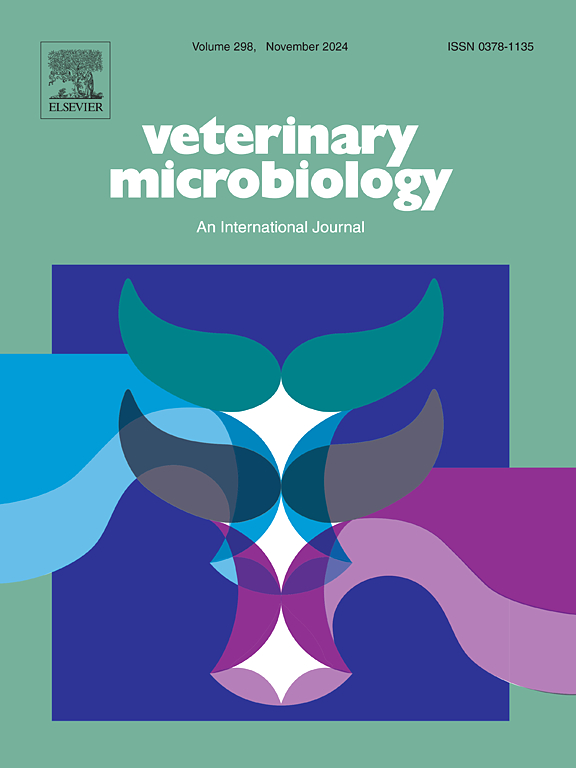Differences in tests of phenotypic colistin resistance in clinical Escherichia coli isolates from poultry and their genetic diversity
IF 2.4
2区 农林科学
Q3 MICROBIOLOGY
引用次数: 0
Abstract
Colibacillosis is one of the most common health problems in poultry production and is associated with high economic losses. The purpose of this study was to determine the phenotypic and genotypic colistin resistance of Escherichia coli isolates obtained from clinical cases of colibacillosis in poultry, together with determination of their phylogenetic groups, and to compare the results of three tests based on the microdilution method for phenotypic evaluation of colistin susceptibility. In addition, to determine the risk to the poultry meat consumer, further analysis of E. coli isolates phenotypically and genotypically resistant to colistin was performed, including determination of their phenotypic and genotypic resistance to other antibiotics, the presence of selected potential virulence factors, and their sequence types. A total of 91 E. coli isolates from laying hens, breeding hens, broiler chickens, and turkeys were tested. Automated test yielded 53.8 % colistin-resistant isolates, while the other two phenotypic tests and the genetic analysis (mcr-1 gene) showed 22 % resistant isolates. The 91 E. coli isolates represented phylogenetic groups D (36.2 %), A (26.4 %), B2 (26.4 %), and B1 (11 %). The mcr-1-positive E. coli isolates included 12 sequence types (ST10, ST95, ST355, ST428, ST744, ST57, ST69, ST117, ST156, ST349, ST410, and ST1196), showed the highest resistance to amoxicillin (100 %), doxycycline (100 %), enrofloxacin (85 %), chloramphenicol (75 %), and amoxicillin/clavulanic acid (55 %) and had combination of resistance genes (blaTEM, tetA, tetB, aadA, strA/strB, aac(3)-II, aphA1, dhfrI, sul1, sul2, sul3, floR, cmlA, catA1) and potential virulence factors (iss, iucD, cvi/cva, tsh, irp2, vat, astA, and papC). Among all phylogenetic groups, the mcr-1-positive E. coli isolates representing group B2 possessed the most potential virulence factors. Notably, the ST95 E. coli isolate represented phylogenetic group B2 and contained the svg and mcr-1 genes, which could pose a real threat to humans.
临床禽源大肠埃希菌表型粘菌素耐药试验差异及其遗传多样性
大肠杆菌病是家禽生产中最常见的健康问题之一,与高经济损失有关。本研究的目的是确定从临床家禽大肠杆菌病病例中分离的大肠杆菌对粘菌素的表型和基因型耐药性,并确定其系统发育类群,并比较基于微量稀释法的三种试验结果对粘菌素敏感性的表型评价。此外,为了确定对禽肉消费者的风险,进一步分析了大肠杆菌分离株对粘菌素的表型和基因型抗性,包括确定其对其他抗生素的表型和基因型抗性,选定的潜在毒力因子的存在及其序列类型。从蛋鸡、种鸡、肉鸡和火鸡中分离出91株大肠杆菌。自动检测结果为53.8株 %粘菌素耐药株,另外两种表型检测和遗传分析(mcr-1基因)显示22株 %耐药株。91株大肠杆菌分别为D(36.2% %)、A(26.4 %)、B2(26.4 %)和B1(11 %)。mcr-1阳性大肠杆菌分离株包括12个序列型(ST10、ST95、ST355、ST428、ST744、ST57、ST69、ST117、ST156、ST349、ST410和ST1196),对阿莫西林(100 %)、多西环素(100 %)、恩诺沙星(85 %)、氯霉素(75 %)和阿莫西林/克拉维酸(55 %)的耐药率最高,耐药基因(blaTEM、tetA、tetB、aadA、strA/strB、aac(3)-II、aphA1、dhfrI、sul1、sul2、sul3、floR、cmlA、catA1)和潜在毒力因子(iss、iucD、cvi/cva、tsh、irp2、vat、astA和papC)。在所有系统发育类群中,B2类群的mcr-1阳性大肠杆菌分离株具有最多的潜在毒力因子。值得注意的是,ST95大肠杆菌分离物属于系统发育群B2,含有svg和mcr-1基因,可能对人类构成真正的威胁。
本文章由计算机程序翻译,如有差异,请以英文原文为准。
求助全文
约1分钟内获得全文
求助全文
来源期刊

Veterinary microbiology
农林科学-兽医学
CiteScore
5.90
自引率
6.10%
发文量
221
审稿时长
52 days
期刊介绍:
Veterinary Microbiology is concerned with microbial (bacterial, fungal, viral) diseases of domesticated vertebrate animals (livestock, companion animals, fur-bearing animals, game, poultry, fish) that supply food, other useful products or companionship. In addition, Microbial diseases of wild animals living in captivity, or as members of the feral fauna will also be considered if the infections are of interest because of their interrelation with humans (zoonoses) and/or domestic animals. Studies of antimicrobial resistance are also included, provided that the results represent a substantial advance in knowledge. Authors are strongly encouraged to read - prior to submission - the Editorials (''Scope or cope'' and ''Scope or cope II'') published previously in the journal. The Editors reserve the right to suggest submission to another journal for those papers which they feel would be more appropriate for consideration by that journal.
Original research papers of high quality and novelty on aspects of control, host response, molecular biology, pathogenesis, prevention, and treatment of microbial diseases of animals are published. Papers dealing primarily with immunology, epidemiology, molecular biology and antiviral or microbial agents will only be considered if they demonstrate a clear impact on a disease. Papers focusing solely on diagnostic techniques (such as another PCR protocol or ELISA) will not be published - focus should be on a microorganism and not on a particular technique. Papers only reporting microbial sequences, transcriptomics data, or proteomics data will not be considered unless the results represent a substantial advance in knowledge.
Drug trial papers will be considered if they have general application or significance. Papers on the identification of microorganisms will also be considered, but detailed taxonomic studies do not fall within the scope of the journal. Case reports will not be published, unless they have general application or contain novel aspects. Papers of geographically limited interest, which repeat what had been established elsewhere will not be considered. The readership of the journal is global.
 求助内容:
求助内容: 应助结果提醒方式:
应助结果提醒方式:


